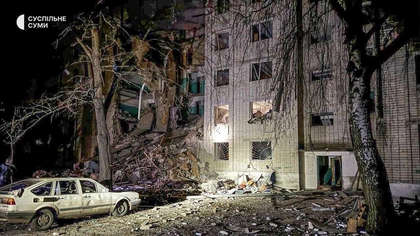A punishing attack on a Russian base that operated and stored Shahed / Geran kamikaze drones destroyed dozens of the robot aircraft in a warehouse and hit a barracks used by Iranian flight instructors, Monday’s Ukrainian Navy statement said.
The June 21 attack was carried out by Ukrainian maritime forces supported by operators from Ukraine’s security services (SBU) resulted in multiple strikes on an air operations and air defense training base in Russia’s southwestern Krasnodar region, close to the Azov Sea coastal town of Yeysk, according to Kyiv’s official announcement.
JOIN US ON TELEGRAM
Follow our coverage of the war on the @Kyivpost_official.
The overnight attack hit Russia’s 726th Air Defense Training Center which is used by the Russian military to train service personnel in the use of various types of unmanned aerial vehicles (UAVs) – drones. Ukraine’s military intelligence had previously identified the Yeysk factility as one of several sites used by the Russian military to launch kamikaze drone attacks on Ukrainian homes and businesses.
The June 21 strike hit a warehouse, destroying around 20 Iran-manufactured Shahed-136 kamikaze drones, 50 Russian Lancet kamikaze drones, and 50 reconnaissance drones manufactured by the Russian aerospace company Zala, the Ukrainian navy said.
The strike, reportedly, hit adjacent administrative and living quarters used by Iranian instructors and Russian military personnel. The Ukrainian official statement named three instructors that had been killed as: Gunya, Sadreev and Kazhanov.

US Warns of ’Significant’ Missile Attack on Ukraine as Kremlin Vows Response for ATACAMS Strike
If confirmed, the strike represents one of the most effective Ukrainian counterattacks against Russian long-range strike systems since Russia’s February 2022 invasion. To date, according to official Kyiv counts, Russia has launched almost 5,000 UAVs at Ukraine.The Shahed drone carries a 50-kilogram (110-pound) warhead and is widely used by the Russian military to attack civilian infrastructure, to probe and distract Ukrainian air defenses. The Lancet is a tactical loitering munition most commonly used by Russian special force operators to attack high-value battlefield targets such as anti-aircraft systems, main battle tanks, artillery pieces and communications vehicles.
The attack was not reported by most mainstream Russian media but pro-Kremlin Russian milbloggers, including Rybar-Z, confirmed the facility had been attacked but claimed all incoming weapons were shot down and reported no damage. On the day of the strike Russia’s Defense Ministry in a situation report confirmed Ukrainian forces had fired “Neptune-MD” long-range missiles at unspecified targets but stated all of Kyiv’s missiles were shot down by Russia’s air defenses.
The official Ukrainian Navy statement did not identify the weapons used in the strike. Kyiv Post fact checks found substantial evidence Neptune missiles or similar weapons had badly damaged Russian military infrastructure at the Yeysk site. The Rybar-Z claim that all Ukrainian weapons were intercepted or missed their targets was unfounded. Similarly, the Russian Defense Ministry claim that its forces had shot down Neptune missiles and failed to hit their targets, was also found to be false.Ukrainian and Russian milbloggers, followed by some Ukrainian independent news platforms, reported modified Ukraine-manufactured R-360 Neptune anti-ship missiles carried out the attack. Russian social media in the area of Yeysk reported explosions in the direction of the base, overnight on June 21 and some reported seeing smoke.
Open-source satellite images geo-located by Kyiv Post to the site showed the targeted buildings were located at a secured Russian military training area west of Yeysk near the village of Vorontsovka, on the Azov Sea coast.
Parked vehicles, road tracks, antennae, recently improved roads, fortifications, bunkers and security checkpoints n those images pointed to continued use of the facility by a Russian military unit or units, probably for air defense and training.
Maxar satellite imagery showing buildings at the Russian airfield near the village of Vorontsovka
Recent satellite photographs geo-located at the same location showed a warehouse or storage building and an adjacent barracks or administrative building to have been flattened by multiple explosions, most likely by two or more projectiles that had approached from the northwest. The images showed signs of secondary explosions and a substantial fire.
Ukrainian news platforms citing navy officials in early April reported manufacturers of the Neptune anti-ship missile had modified the weapon to increase its range beyond the listed 300 kilometer (190 mile) maximum range and a warhead configured to cause maximum damage to ground targets.
Graphic detailing Ukraine’s upgraded “Long Neptune” missile, published by US military analyst Chuck Pfarrer on June 24.
Two Neptune missiles are believed to have been responsible for sinking the Russian Navy’s Black Sea flagship, the cruiser Moskva, on April 14 2022.
Said to have been built with lighter, more modern construction materials, and equipped with newer, more advanced guidance systems, the upgraded missile, often referred to as “Long Neptune,” has a reported range of at least 1,000 kilometers (620 miles).
The first reported use of upgraded Neptune missiles was on April 21, when they broke through Russian air defenses protecting the Black Sea Fleet (BSF) main base in Sevastopol, and scored at least one hit on a Russian Navy heavy salvage ship tied up a military wharf at the port.
According to a Ukrainian Air Force statement, on June 22, one day after the missile attack against the Yeysk facility, Russian forces launched a major attack against Ukrainian infrastructure targets, employing 14 cruise missiles and 13 Shahed drones.
In past strikes, the Kremlin had almost always launched two or even four times as many cheap drones as missiles in an attempt to distract Ukrainian air defenses, and often followed up major missile raids with drones launched the next day to probe Ukrainian air defenses.
Since June 22, according to official Ukrainian military reports, Russian forces had launched no Shahed drones into Ukrainian air space. It was not clear if the pause in Shahed launches was linked to damage or casualties following the June 21 attack on the Yeysk facility.
You can also highlight the text and press Ctrl + Enter








